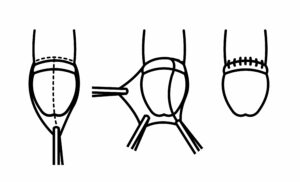Overview
Circumcision is surgical removal of the foreskin. Some of the reasons for needing a circumcision are:
- recurrent infection of the head of the penis or foreskin (balanitis or balanoposthitis)
- recurrent tears of the foreskin
- narrowing of the foreskin (phimosis)
- hygiene reasons
- religious purposes
DAY SURGERY
In most cases, circumcision can be done as a day surgery procedure, in the hospital. The patient is usually given general anaesthesia or intravenous sedation to ensure that there is no discomfort during the procedure.
CONVENTIONAL AND LASER CIRCUMCISION
During circumcision, the foreskin is removed with conventional surgical instruments (conventional circumcision) or with laser. The preferred method will depend on the severity of the phimosis and patient preference. After that, the wound is carefully closed with stitches that will disappear after a few weeks.

Diagram showing conventional circumcision.
Image from chernous/Adobe Stock
SAFETY
In our experience, circumcision is a safe procedure. The most common side effects after the procedure are wound discomfort and minor bleeding, which will settle after a few days. In children, one of the possible side effects is that the remaining penile skin may stick back to the head of the penis.
AGE RANGE FOR CIRCUMCISION
We perform circumcision for:
• children around 11 years of age and above (for medical reasons)
INSURANCE COVERAGE
